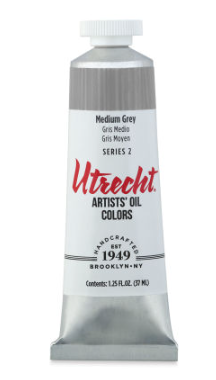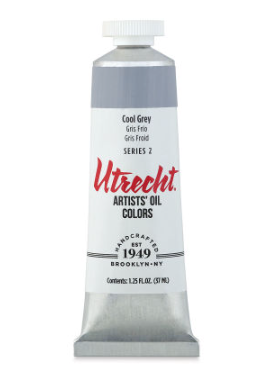Are you struggling to mix neutral tones and to control temperature when working straight from the tube? Are you overwhelmed by all the shades of grey? I’m impressed by the thinking Utrecht has put into these paints as it’s clear they understand the challenges artists face and the nuanced differences between the various black and white paints. Each one of these features precisely-controlled mixtures that make it possible for oil painters to pinpoint the value and temperature of their colors. Check out the details below, and see how their values stack up!
Utrecht Artist’s Oil Color: Cool Grey
This grey is wonderful combination of Zinc White, Titanium White, and Mars Black. The inclusion of Zinc White, a more translucent paint than Titanium, makes this paint effective for desaturating colors and a relatively long drying time makes this a useful option for glazing.

Utrecht Artist’s Oil Color: Warm Grey
A complement to the Cool Grey above, this Warm Grey tints colors and helps control color temperature through its use of mixture of Titanium White, Mars Black and Red Iron Oxide.

Utrecht Artist’s Oil Color: Medium Grey
This grey controls color temperature by balancing the cool quality of a Titanium White/Mars Black combination with the warmth of Red Iron Oxide.

Utrecht Artist’s Oil Color: Spectrum Black
Some painters prefer to leave black paint off a palette entirely, opting to mix darks with combinations of other pure pigments for a more specific color decision than black used from a tube. This Spectrum Black does that work for you by mixing Prussian Blue, Quinacridone Violet, and Nickel Azo Yellow.

This article contains affiliate links that help us earn a small commission from purchases — at no additional cost to you. We are grateful for your support.

